Makroökonomische Analysen und Prognosen
Die Forschungsgruppe erstellt makroökonomische Analysen und Prognosen als Grundlage für eine faktengeleitete Wirtschaftspolitik, für die Implementierung stabilisierender Wirtschaftspolitik und für die Identifikation makroökonomischer Ungleichgewichte oder Instabilitäten.
IWH-Datenprojekt: IWH Macrometer: Macroeconomic Database for the German Länder, East and West Germany
Alle makroökonomischen Analysen, Prognosen und wirtschaftspolitischen Papiere der Gruppe finden Sie im Bereich Aktuelle Konjunktur.
Das IWH ist Mitglied in der AIECE (Association d'instituts européens de conjoncture économique).
Forschungscluster
Wirtschaftliche Dynamik und StabilitätIhr Kontakt

- Abteilung Makroökonomik
PROJEKTE
07.2016 ‐ 06.2022
Gemeinschaftsdiagnose (laufend)
Bundesministerium für Wirtschaft und Energie (BMWi)
Die Gemeinschaftsdiagnose ist ein Instrument zur Beurteilung der gesamtwirtschaftlichen Lage und Entwicklung in Deutschland, der Euroregion und der übrigen Welt. Zu diesem Zweck werden für die Weltwirtschaft und ihre Hauptregionen Konjunkturprognosen generiert. Für den Euroraum und die deutsche Wirtschaft werden daraus wirtschaftspolitische Empfehlungen abgeleitet. Das Anliegen der Gemeinschaftsdiagnose, die im Auftrag des Bundesministeriums für Wirtschaft und Technologie durchgeführt wird, ist die Abgabe einheitlicher Einschätzungen durch die teilnehmenden Institute. Die Ergebnisse werden halbjährlich als Frühjahrs- und Herbstgutachten publiziert.
01.2013 ‐ 12.2018
IWH-Flash-Indikator
Verlagsgruppe Handelsblatt
12.2015 ‐ 12.2016
Konferenz "Wie können wir den Wettbewerb im Dienstleistungssektor ankurbeln?"
Europäische Kommission
07.2013 ‐ 06.2016
Gemeinschaftsdiagnose
Bundesministerium für Wirtschaft und Energie (BMWi)
Die Gemeinschaftsdiagnose ist ein Instrument zur Beurteilung der gesamtwirtschaftlichen Lage und Entwicklung in Deutschland, der Euroregion und der übrigen Welt. Zu diesem Zweck werden für die Weltwirtschaft und ihre Hauptregionen Konjunkturprognosen generiert. Für den Euroraum und die deutsche Wirtschaft werden daraus wirtschaftspolitische Empfehlungen abgeleitet. Das Anliegen der Gemeinschaftsdiagnose, die im Auftrag des Bundesministeriums für Wirtschaft und Technologie durchgeführt wird, ist die Abgabe einheitlicher Einschätzungen durch die teilnehmenden Institute. Die Ergebnisse werden halbjährlich als Frühjahrs- und Herbstgutachten publiziert.
09.2015 ‐ 03.2016
Messung der Elastizität der veranlagten Einkommensteuer in Relation zu den Unternehmens- und Vermögenseinkommen
Bundesministerium der Finanzen (BMF)
01.2013 ‐ 12.2015
Ökonomische Wirksamkeit der Konjunktur stützenden finanzpolitischen Maßnahmen der Jahre 2008 und 2009
Bundesministerium der Finanzen (BMF)
01.2012 ‐ 12.2015
Vierteljährliche Konjunkturberichterstattung für Sachsen-Anhalt
Ministerium für Wirtschaft, Wissenschaft und Digitalisierung des Landes Sachsen-Anhalt
Die Vierteljahresrechnung zur Entwicklung der gesamtwirtschaftlichen Produktion und der Erwerbstätigkeit in Sachsen-Anhalt fußt auf unterjährigen sektoralen Indikatoren und wird mit einer Verzögerung von drei Wochen gegenüber den Berechnungen des Statistischen Bundesamtes für Deutschland veröffentlicht. Der Abgleich mit den nur jährlich verfügbaren amtlichen Angaben zur Produktion des abgelaufenen Jahres erfolgt jeweils im März des Folgejahres unter Nutzung der Veröffentlichung des Arbeitskreises Volkswirtschaftliche Gesamtrechnungen der Länder.
‐
Business Cycle Forecasts and Stress Scenarios
Volkswagen Financial Services AG
Referierte Publikationen

Can R&D Subsidies Counteract the Economic Crisis? – Macroeconomic Effects in Germany
in: Research Policy, Nr. 3, 2015
Abstract
During the economic crisis of 2008 and 2009, governments in Europe stabilized their economies by means of fiscal policy. After decades of absence, deficit spending was used to counteract the heavy decline in demand. In Germany, public spending went partially into R&D subsidies in favor of small and medium sized enterprises. Applying the standard open input–output model, the paper analyzes the macroeconomic effects of R&D subsidies on employment and production in the business cycle. Findings in the form of backward multipliers suggest that R&D subsidies have stimulated a substantial leverage effect. Almost two thirds of the costs of R&D projects are covered by the enterprises themselves. Overall, a subsidized R&D program results in a production, value added and employment effect that amounts to at least twice the initial financing. Overall, the R&D program counteracts the decline of GDP by 0.5% in the year 2009. In the year 2010 the effects are already procyclical since the German economy recovered quickly. Compared to the strongly discussed alternative uses of subsidies for private consumption, R&D spending is more effective.
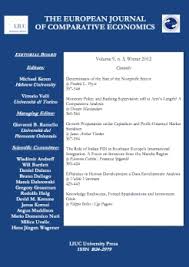
Skill Content of Intra-european Trade Flows
in: European Journal of Comparative Economics, Nr. 1, 2013
Abstract
In recent decades, the international division of labor has expanded rapidly in the wake of European integration. In this context, especially Western European high-wage countries should have specialized on (human-)capital intensively manufactured goods and should have increasingly sourced labor-intensively manufactured goods, especially parts and components, from Eastern European low wage countries. Since this should be beneficial for the high-skilled and harmful to the lower-qualified workforce in high-wage countries, the opening up of Eastern Europe is often considered as a vital reason for increasing unemployment of the lower-qualified in Western Europe. This paper addresses this issue by analyzing the skill content of Western European countries’ bilateral trade using input-output techniques in order to evaluate possible effects of international trade on labor demand. Thereby, differences in factor inputs and production technologies have been considered, allowing for vertical product differentiation. In this case, skill content of bilateral exports and imports partially differs substantially, especially in bilateral trade between Western and Eastern European countries. According to the results, East-West trade should be harmful particularly to the medium-skilled in Western European countries.
Arbeitspapiere
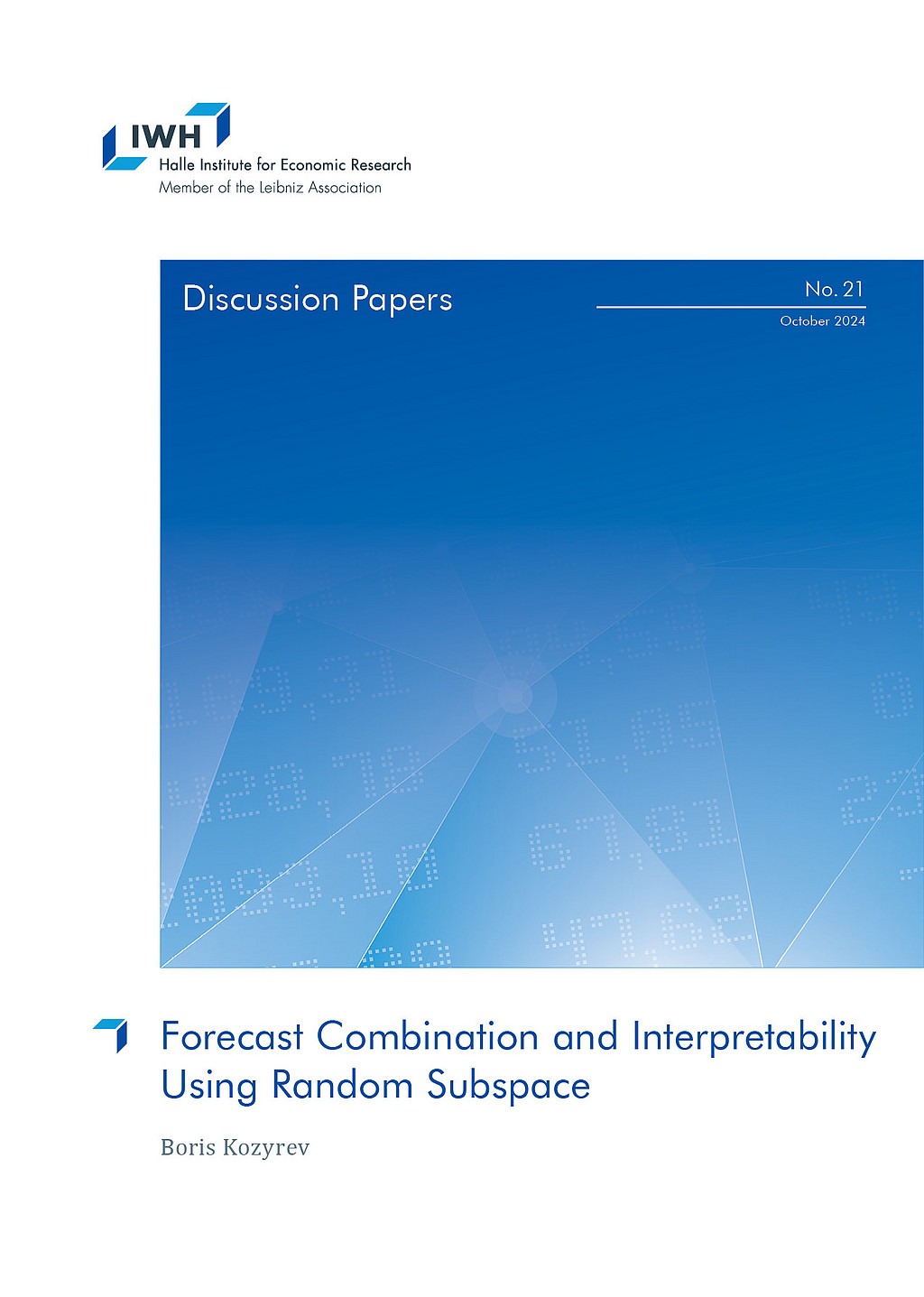
Forecast Combination and Interpretability Using Random Subspace
in: IWH Discussion Papers, Nr. 21, 2024
Abstract
<p>This paper investigates forecast aggregation via the random subspace regressions method (RSM) and explores the potential link between RSM and the Shapley value decomposition (SVD) using the US GDP growth rates. This technique combination enables handling high-dimensional data and reveals the relative importance of each individual forecast. First, it is possible to enhance forecasting performance in certain practical instances by randomly selecting smaller subsets of individual forecasts and obtaining a new set of predictions based on a regression-based weighting scheme. The optimal value of selected individual forecasts is also empirically studied. Then, a connection between RSM and SVD is proposed, enabling the examination of each individual forecast’s contribution to the final prediction, even when there is a large number of forecasts. This approach is model-agnostic (can be applied to any set of predictions) and facilitates understanding of how the aggregated prediction is obtained based on individual forecasts, which is crucial for decision-makers.</p>
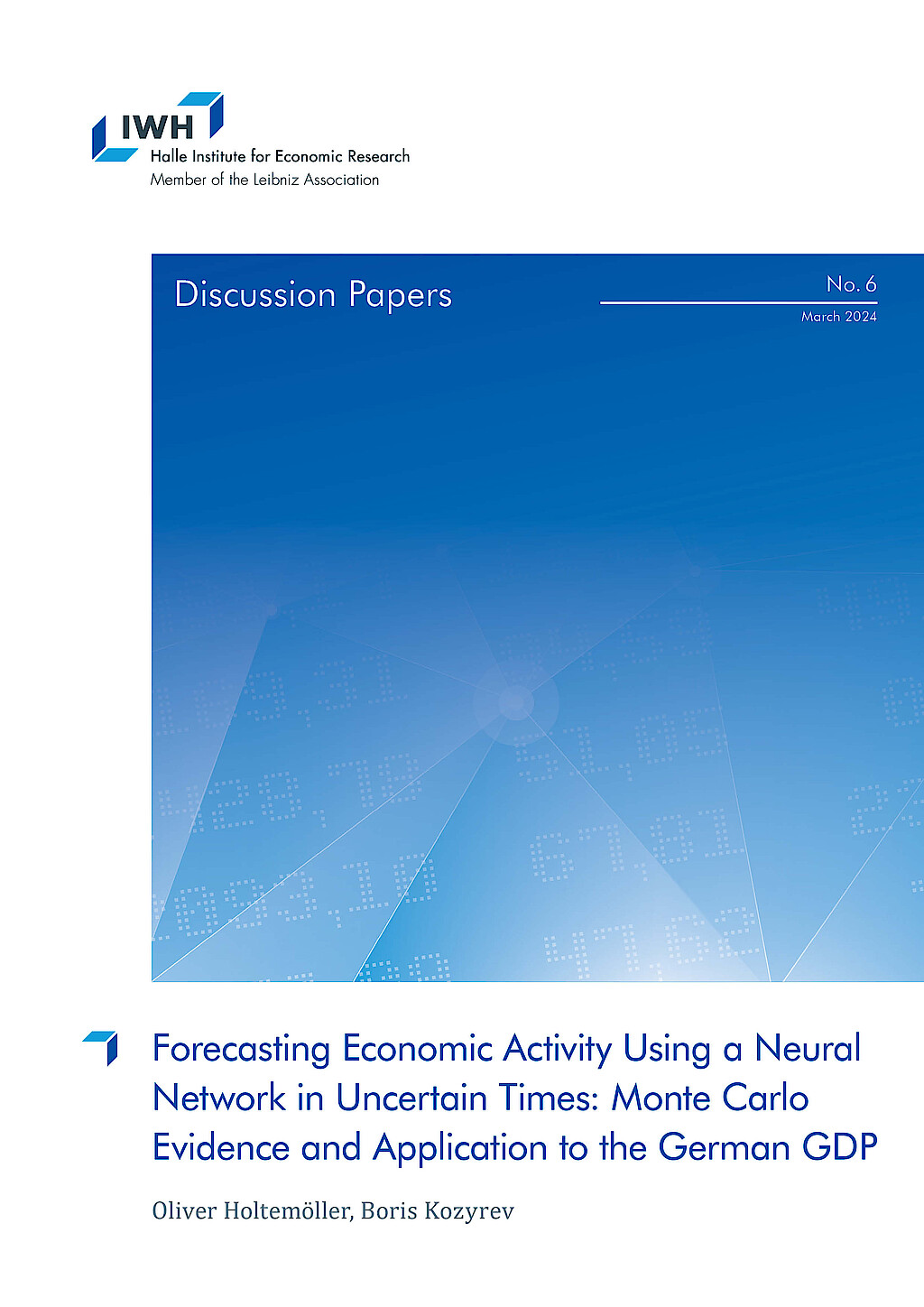
Forecasting Economic Activity Using a Neural Network in Uncertain Times: Monte Carlo Evidence and Application to the German GDP
in: IWH Discussion Papers, Nr. 6, 2024
Abstract
In this study, we analyzed the forecasting and nowcasting performance of a generalized regression neural network (GRNN). We provide evidence from Monte Carlo simulations for the relative forecast performance of GRNN depending on the data-generating process. We show that GRNN outperforms an autoregressive benchmark model in many practically relevant cases. Then, we applied GRNN to forecast quarterly German GDP growth by extending univariate GRNN to multivariate and mixed-frequency settings. We could distinguish between “normal” times and situations where the time-series behavior is very different from “normal” times such as during the COVID-19 recession and recovery. GRNN was superior in terms of root mean forecast errors compared to an autoregressive model and to more sophisticated approaches such as dynamic factor models if applied appropriately.
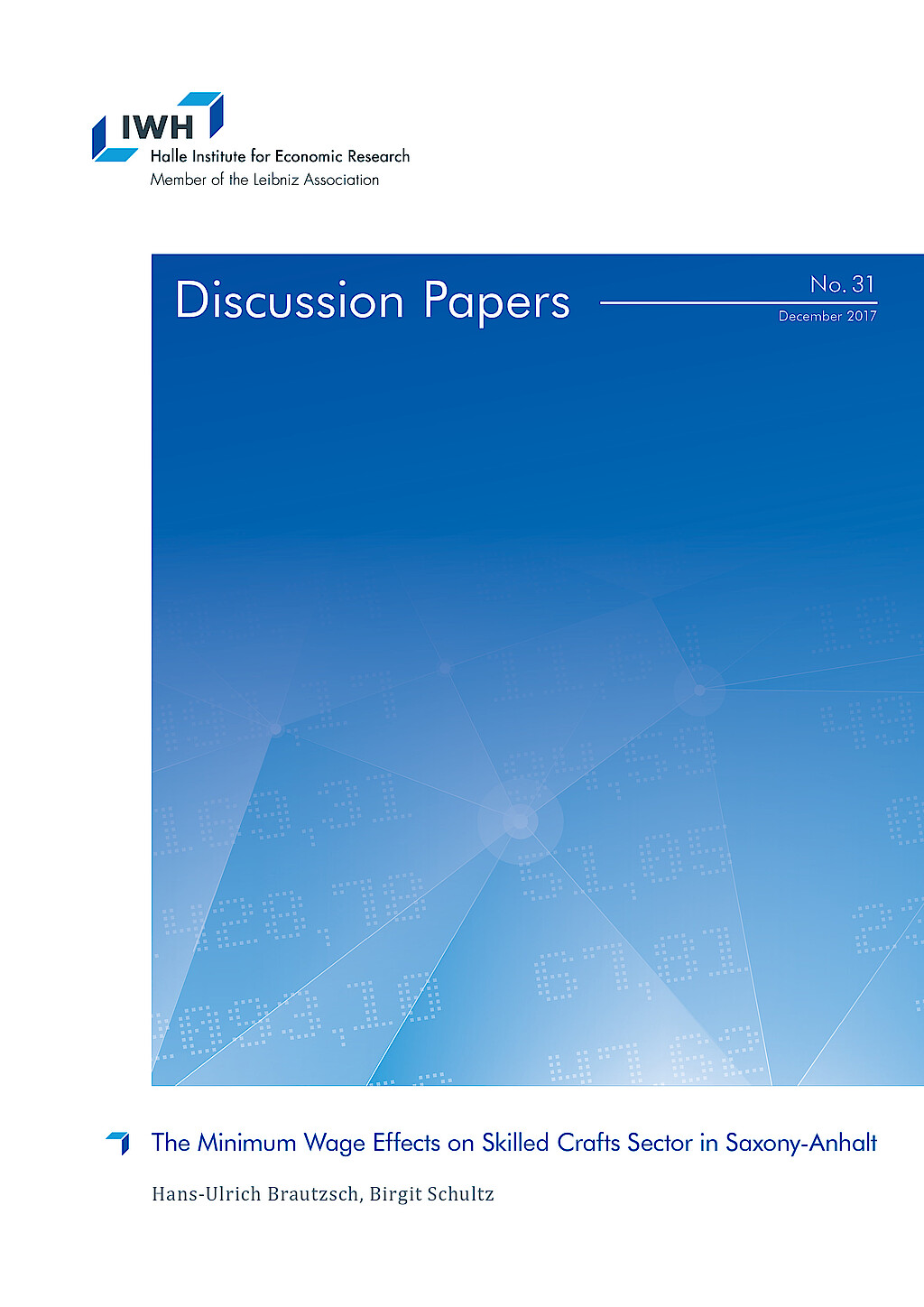
The Minimum Wage Effects on Skilled Crafts Sector in Saxony-Anhalt
in: IWH Discussion Papers, Nr. 31, 2017
Abstract
This paper examines the effects of the minimum wage introduction in Germany in 2015 on the skilled crafts sector in Saxony-Anhalt. Using novel survey data on the skilled crafts sector in Saxony-Anhalt, we examine three questions: (1) How many employees are affected by the minimum wage introduction in the skilled crafts sector in Saxony- Anhalt? (2) What are the effects of the minimum wage introduction? (3) How have firms reacted to wage increase? We find that about 8% of all employees in the skilled crafts sector in Saxony-Anhalt are directly affected by the minimum wage introduction. A difference-in-difference estimation reveals no significant employment effects of the minimum wage introduction. We test for alternative adjustment strategies and observe a significant increase of output prices.
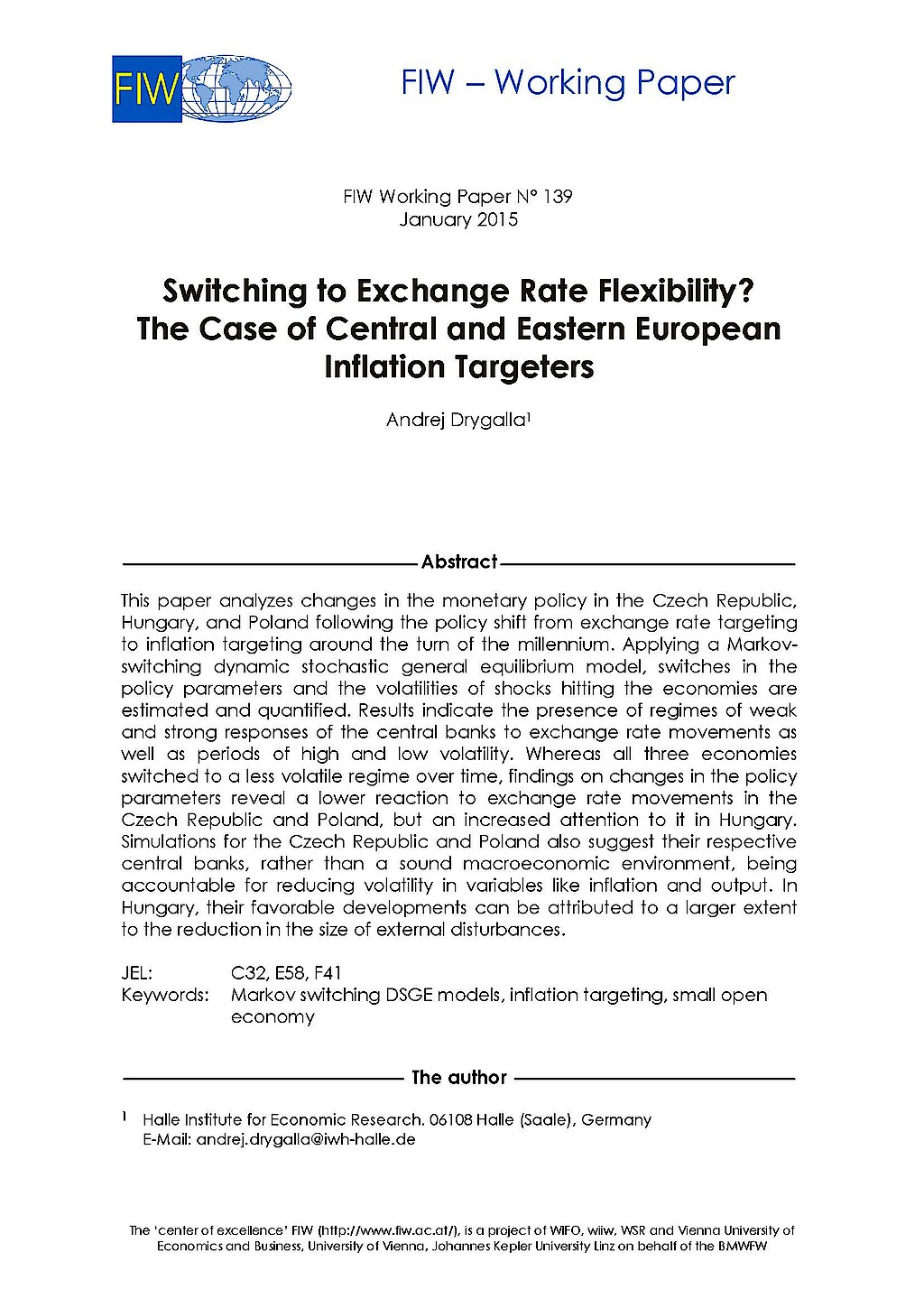
Switching to Exchange Rate Flexibility? The Case of Central and Eastern European Inflation Targeters
in: FIW Working Paper, Nr. 139, 2015
Abstract
This paper analyzes changes in the monetary policy in the Czech Republic, Hungary, and Poland following the policy shift from exchange rate targeting to inflation targeting around the turn of the millennium. Applying a Markovswitching dynamic stochastic general equilibrium model, switches in the policy parameters and the volatilities of shocks hitting the economies are estimated and quantified. Results indicate the presence of regimes of weak and strong responses of the central banks to exchange rate movements as well as periods of high and low volatility. Whereas all three economies switched to a less volatile regime over time, findings on changes in the policy parameters reveal a lower reaction to exchange rate movements in the Czech Republic and Poland, but an increased attention to it in Hungary. Simulations for the Czech Republic and Poland also suggest their respective central banks, rather than a sound macroeconomic environment, being accountable for reducing volatility in variables like inflation and output. In Hungary, their favorable developments can be attributed to a larger extent to the reduction in the size of external disturbances.

Die Learning Economy aus Netzwerkperspektive: Mechanismen und Probleme
in: Jenaer Beiträge zur Wirtschaftsforschung, Nr. 4, 2006
Abstract
Im Mittelpunkt der gegenwärtigen ökonomischen Entwicklung steht verstärkt Wissen als fundamentale Ressource und Triebkraft wirtschaftlichen Wachstums sowie Lernen als der bedeutendste Prozess. Diese Sichtweise wird durch das theoretische Konstrukt der Learning Economy beschrieben. Die Organisationsform des Netzwerkes gilt dabei als geeignetes Arrangement, um die Teilnahme an Lernprozessen sowie den Zugangs zu einer breiten und diversifizierten Wissensbasis zu gewährleisten. In der vorliegenden Arbeit werden im Rahmen der konzeptionellen Charakteristika der Learning Economy die möglichen Ausprägungen einer aktiven Netzwerktätigkeit, die erfolgsdeterminierenden Mechanismen eines Netzwerkes als auch die mit einem Netzwerkarrangement verbundenen Probleme dargelegt. Es zeigt sich einerseits, dass Netzwerke grundsätzlich einen geeigneten Mechanismus darstellen, um den Notwendigkeiten einer Learning Economy zu begegnen. Andererseits wird ersichtlich, dass die Funktionsfähigkeit von Netzwerken und das Ausschöpfen der vorhandenen Möglichkeiten keinesfalls ohne konstante Anstrengungen der Partner und ein detailliertes Verständnis der zentralen Wirkungszusammenhänge erreicht werden kann. Daher ist die zum Teil euphorisch praktizierte Netzwerkdiskussion in mancher Hinsicht differenziert zu betrachten. Besonders der Abfluss ökonomisch sensiblen Wissens, der nicht-wechselseitige Wissensaustausch sowie die Abschottung bestimmter regionaler Netzwerkstrukturen können schwerwiegende Folgen nach sich ziehen.














